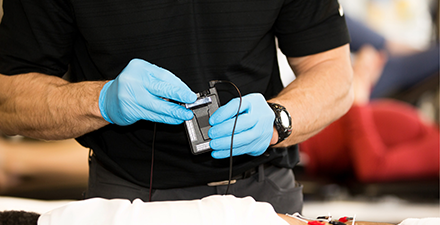Wound management needs to be addressed by a multidisciplinary team, with physical therapists playing a key role throughout: that's the theme of a new white paper that describes the current state of PTs in wound management. It serves as a resource for PTs, providers, payers, and policymakers thinking about the future of treatment.
"The Role of Physical Therapists in Wound Management (.pdf)" is an attempt to capture what PTs bring to the table when it comes to wound management, from the ways PT education programs prepare students for work in this area, to the specific interventions used, to the ways in which PTs are involved with treatment across practice settings. "The document supports wound management as an area of specialization for physical therapists," said Karen Gibbs, PT, DPT, PhD, coauthor of the white paper," since it provides clear delineation between the training and experience of the generalist PT and the PT who specializes in wound management." Gibbs is a board-certified clinical specialist in clinical electrophysiology and a diplomate of the American Board of Wound Management.
The paper also highlights issues related to state scope-of-practice provisions and payment considerations. The white paper was created by the Wound Management Special Interest Group of the APTA Academy of Clinical Electrophysiology and Wound Management.
"Previous documents on this subject addressed more narrow topics related to the roles of PTs in wound management, often focusing on the use of biophysical technologies," said Stephanie Woelfel, PT, DPT, the paper’s other coauthor." This paper looks at the broader ways in which PTs are involved in wound management and how we can leverage our unique skills to make a difference for our patients with wounds." Woelfel is also a board-certified clinical specialist in clinical electrophysiology and a fellow of the College of Clinical Wound Specialists.
The paper includes charts describing entry-level and postprofessional PT knowledge and skills related to normal tissue healing, examination, systems review, tests and measures, wound etiology and differential diagnosis, psychosocial considerations, and interventions. Additionally, the resource explores the specific interventions PTs use for wounds associated with pressure injuries, diabetes, and venous and arterial vascular insufficiencies.
According to Woelfel, the white paper is an attempt to provide education on the PT's role in hopes of moving the needle on collaborative care models in wound management.
"The 'collaborative model' of wound management is often discussed as the ideal, but depending on where you practice, or even your practice setting, the reality often looks different," Woelfel said. "The goal of this paper was to provide support for those collaborative models that are already in place and to offer a way to get conversations started where increased PT involvement in wound management is needed."
As these models are developed, Woelfel explained, payment issues should not be an afterthought. That's why the paper includes a section on what PTs need to consider when it comes to payment, including relevant CPT codes and links to documentation resources.
"The biggest message we're pushing regarding payment is the absolute necessity for clinicians practicing in wound management to truly understand what PTs can bill for and how to effectively monitor and do it," Woelfel said. "The days when PTs could rely on a manager to handle all of the billing stuff are gone."
